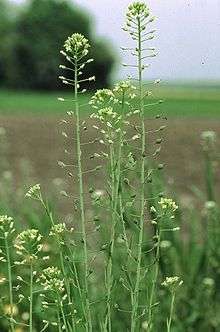Camelina
Camelina is a genus within the flowering plant family Brassicaceae. The Camelina species, commonly known as false flax, are native to Mediterranean regions of Europe and Asia. Most species of this genus have been little studied, with the exception of Camelina sativa, historically cultivated as an oil plant. Heinrich Johann Nepomuk von Crantz was the first botanist to use the genus Camelina in his classification works in 1762. As a way to reduce fossil fuel emissions, the US Navy tested a 50-50 mix of jet aviation fuel and biofuel derived from camelina seeds in 2010.[1] A study published in December 2016 explained that the current low price of conventional kerosene-based jet fuel makes it cost-prohibitive for commercial airlines to use camelina-based jet fuel. The study said substantial government intervention would be one way to create a market for camelina, by combining 9 percent government subsidy on camelina crop production, with 9 percent tax on the conventional fuel.[2]
| Camelina | |
|---|---|
 | |
| Camelina sativa | |
| Scientific classification | |
| Kingdom: | Plantae |
| Clade: | Tracheophytes |
| Clade: | Angiosperms |
| Clade: | Eudicots |
| Clade: | Rosids |
| Order: | Brassicales |
| Family: | Brassicaceae |
| Genus: | Camelina Crantz |
| Species | |
| |
Etymology
The name Camelina comes from the Greek for "ground" and "flax", alluding to its being a weed which suppresses the vigour of flax crops.[3]
Description
Camelina plants are annual or biennial herbs. Their leaves are simple, lanceolate to narrowly elliptic. The flowers are hermaphroditic actinomorphic, grouped in racemes, and yellowish colored. The seeds are formed in dehiscent siliques.[4]
Genetics
The first full genome sequence for Camelina sativa was released on August 1, 2013, by a Canadian research team. The genome sequence and its annotation are available in a genome viewer format and enabled for sequence searching and alignment.[5] Technical details of Camelina's genome sequence were published on April 23, 2014 in the academic journal Nature Communications.[6]
Rothamsted Institute in the UK developed genetically modified Camelina sativa plants that accumulate in their seeds high levels of the longer chain omega-3 oils EPA and DHA, commonly found in fish oils. These plants could provide terrestrial sustainable sources of longer chain omega-3 fatty acids and have benefits for human health and the environment.[7] Field trials were underway in 2016.[8]
Species
Four common species are presented below. However, at least two databanks indicate more species may exist.[9]
- Camelina alyssum
- Camelina microcarpa
- Camelina rumelica
- Camelina sativa
Biodiesel
Biodiesel made from camelina has a variety of benefits. First, traditional petroleum or diesel fuel is not renewable resources, the production of these resources is finite. Camelina biodiesel, however, is a renewable resource. Camelina based aviation fuel could save 84% of carbon emissions [10]. Camelina biodiesel can be produced in large quantities as feedstocks are enough. Moreover, camelina biodiesel can reduce the country's dependence on fossil resources, which can ensure the country's energy security. In addition, camelina biodiesel is an environmentally friendly fuel, and it is biodegradable.[11] Besides, the development of the camelina biodiesel industry can bring employment opportunities. The government has given the industry strong support since camelina biodiesel has a variety of benefits. Therefore, camelina biodiesel has policy support. What’s more, the development of the camelina biodiesel industry has brought great economic benefits. According to the investigation, the greenhouse gas emission of camelina biodiesel produced under no-tillage method is lower than that of traditional methods.[12]
References
- "From Seed to Supersonic" (PDF). Currents. US Navy. Winter 2011. Archived from the original (PDF) on 2018-02-19. Retrieved 2016-11-05.
- "Camelina oil could be economically feasible as source of commercial jet fuel, new OSU analysis shows". Oregon State University Extension and Agricultural Research News. 2017-02-17. Cite journal requires
|journal=(help) - Attractions, Western Australian Herbarium, Biodiversity and Conservation Science, Department of Biodiversity, Conservation and. "FloraBase—the Western Australian Flora". florabase.dec.wa.gov.au.
- "Plantes et botanique - le genre Camelina". Plantes et botanique.
- "Camelina sativa Genome Project". Prairie Gold. Retrieved 2013-08-01.
- "The emerging biofuel crop Camelina sativa retains a highly undifferentiated hexaploid genome structure". Nature Communications. Retrieved 2014-04-23.
- "Crop plants - "green factories" for fish oils". Rothamsted Research. Retrieved 2016-11-04.
- "Researchers apply to trial crop of high-yielding GM wheat". Financial Times. 2016-11-05. Retrieved 2016-11-05.
- "Camelina — The Plant List". www.theplantlist.org.
- "Camelina jet fuel could cut carbon emissions by 84 percent". phys.org. Retrieved 2020-05-19.
- Quan, He (2016). "An evaluation of biodiesel production from Camelina sativa grown in Nova Scotia". Industrial Crops & Products. 81: 162–168. doi:10.1016/j.indcrop.2015.11.073.
- Dangol, Namrata (2017). "Life-cycle energy, GHG and cost comparison of camelina-based biodiesel and bio jet fuel". Boules: 1–9. doi:10.1080/17597269.2017.1369632.